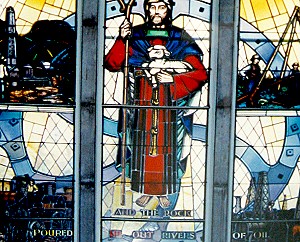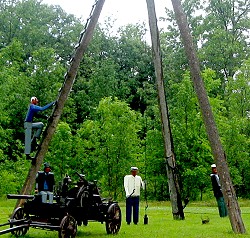
Who knew that there was a little taste of Texas way up in Ontario?
Yup, oil that is, black gold, Texas tea, a Canadian story ripped right from the antics of the Beverly Hillbillies.
Like Jed Clampett, the locals thought the greasy goo oozing out of the ground was just a nuisance until some city slickers came along and wanted to pay for it, that is.

The whole story is told at The Oil Museum of Canada in Oil Springs, just South of Oil City and Petrolia, on the corner of Oil Heritage Road and Gum Bed Line.
By the way things are named around here, we started to get the idea that oil’s big in these parts.
So big in fact, that it’s been immortalized in the stained-glass windows at the Christ Anglican Church in Petrolia.
 Yup, those panes next to Jesus, usually reserved for the saints and such, are all filled with scenes from the nearby oil fields.
Yup, those panes next to Jesus, usually reserved for the saints and such, are all filled with scenes from the nearby oil fields.
Under his feet reads “And The Rock Poured Me Out Rivers Of Oil.” We had no idea that Jesus was so into fossil fuels.
150 years ago, the few folks scratching out a living on this strip of land between Lake Huron and Lake Erie didn’t think much of the nasty, black tar they called gum. All it was good for was ruining their land and water.
But then, in 1858, someone hatched a plan to use the gunk for asphalt to pave roads. The men started digging up the gum, standing in the awful muck, scooping it up in buckets and sending it off to the Big City where folks had use for it.

This digging of gum revealed an unexpected surprise, underneath the tar there was oil!
Back then oil was used for lamps, lubrication, paraffin, medicines and other necessities but not so much as a fuel.
The gasoline that was left over in the refining process was burned off as waste since there were not yet any internal combustion engines to use it.
All of that “waste” would come in quite handy about now, wouldn’t it?
An Oil Rush commenced and thissouthernmost section of Canada was absolutely crawling with prospectors. In fact, the first commercial oil well in North America was in this area.

Here’s where the Mother of Invention stepped in, an ingenious device called a jerker system was invented to pump oil from numerous wells at the same time using just one steam engine.
Remarkable in its complex simplicity, a maze of cables, connectors and wooden rods harnesses the power from the large engine and sends it to pumps all over the field some of them thousands of yards away.
In fact, a working example is still in use, pumping away on the Oil Museum grounds.

The Oil Museum sits right on the site of the first well and the smell of oil literally hangs in the air. Inside the main building there are two floors of exhibits.
The first housing displays of interesting oil business and technology memorabilia. Antique oil cans, service station signs, advertisements are mixed in with diagrams and descriptions of the geology and machinery that make up the history of the oil business.

One display seemed a bit too excited about what it called the world’s first oil spill! The flow from this gusher decimated the area with 100,000 barrels of crude fouling the fields and water all the way to Lake St. Clair.
Now that’s something to celebrate! Not.
The main floor also includes a theater showing a short and somewhat hokey film that gives a fact filled look at the story of North America’s first oil patch through the eyes of a letter writin’ Oil Rusher’s wife.

The basement is another story (no pun intended). A strange conglomeration
of artifacts with nothing whatsoever to do with oil, or even Canada for that matter, are laid out for perusal.
Bugs and guns, a collection of eggs, scarves and clocks, knives and spears from around the world are all displayed in glass cases and along the walls.
But, wait, there’s more — what arrangement is complete without an opium pipe, a conch shell or an elephant tooth?
The curators vaguely tied the items into the museum by pointing out that there is oil in the places where they came from and that oil men kept them as souvenirs.

For us, the most entertaining part of the museum was the Oil Springs Heritage District Driving Tour.
We drove the two mile loop on the nearby roads and found goofy life-sized dioramas of odd metal sculpted men and beasts of burden in old-timey oil production scenes.
Each spot has its own radio frequency, so we tuned into narrations from Angus but you can call me Slick (get it–like “Oil Slick”) in his Texas drawl over a background of delta blues music. Of course, this IS the deep
South, of Canada, so that makes it all fit right in, eh?
Y’all come back now, y’here?
David & Veronica, GypsyNester.com



I just love the way you portray this museum and its history. Up to now I didn’t even know they found oil in this region of Canada. I thought the only place where they dig up oil in this country is in Alberta. Thus, thanks for sharing this interesting bit of knowledge, which I also shared with the readers of my ePaper at http://paper.li/T_W_O/1326445527.
We had no idea until we got there. It was some of the first oil discovered in North America.